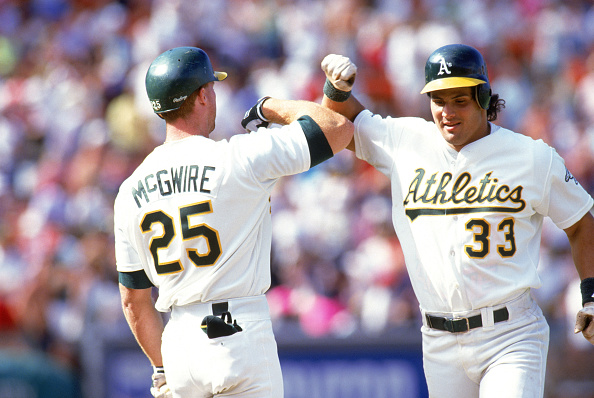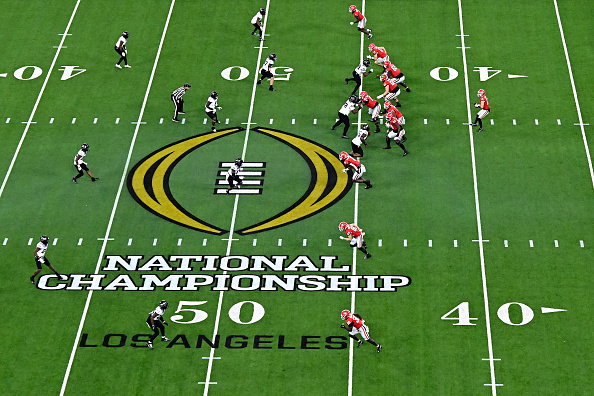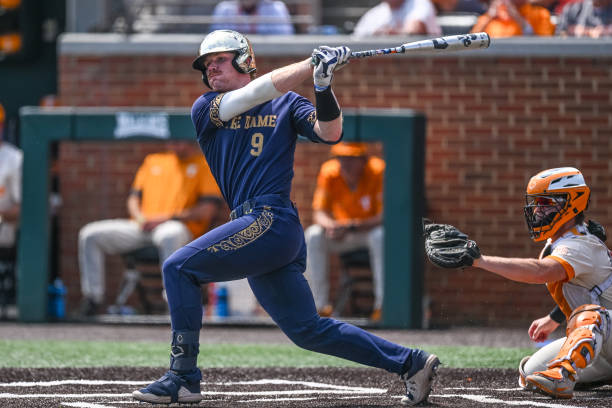Alex Kielar | April 17th, 2019
Every Tuesday or Wednesday we will take a look at the history of one team. You will get some background, iconic players and moments, and postseason results. This week, let’s take a look at the Athletics, better known as the A’s, who have moved around a few times in their 118-year history.
Background
Founded in 1901 as one of the original eight AL teams, the A’s were originally based in Philadelphia. Iconic Hall of Fame manager Cornelius McGillicuddy, famously known as Connie Mack was their first manager and went down to being the winningest and longest-tenured manager in baseball history, holding the helm of the A’s for 50 years.
Early/Philadelphia Years
The A’s saw much success during their first decade, as they held a winning record each of their first seven seasons, which included AL pennants in 1902 and 1905 and their first World Series berth in the latter year. In that first World Series for Philadelphia, they came up on the short end of the stick versus the New York Baseball Giants. The A’s second World Series appearance came in 1910 in which they won in five games over the Chicago Cubs, and they returned in 1911 to defeat the New York Giants in six games.
The A’s were located in Philadelphia through 1954, in which they won three more World Series, in 1913, 1929, and 1930. Following their title year in 1913, the A’s made it back to the World Series in 1914 where they ultimately lost, and it was downhill from there. Following the season, Mack was forced to sell off his star players to other teams as a Federal League was formed. The result of this was the A’s following up their stretch of early dominance with a woeful stretch of 10 straight losing seasons from 1915-1924, which included an atrocious 117 loss season in 1916. They finally found their mojo again in 1925, where they had their first winning record since their last World Series appearance in 1914. The A’s were helped that season by the Major League debuts of three future Hall of Famers in first baseman Jimmie Foxx, pitcher Lefty Grove, and catcher Mickey Cochrane.
The A’s finished 2nd in the American League in 1927 and 1928 behind the powerhouse “Murderer’s Row” Yankees, one of the most dominant teams in MLB history. Stay tuned for Yankees’ Team History coming in a later week in this series. Back to the A’s, they were able to make it back to the World Series in 1929 where they would defeat the Cubs once again. They would make it to three straight World Series, facing the St. Louis Cardinals in the two years following 1929, winning in six games in 1930, and then falling in seven games in 1931.
Following those dynasty years, the A’s tumbled once again, placing last in 11 of the next 20 seasons and never placing higher than 4th place for their final seasons in Philadelphia.
Moving to Kansas City
With the team’s long stretch of poor play and the rise of the crosstown National League team in the Phillies, the A’s ownership, under the Mack family, was put under much financial strain and scrutiny and were forced to sell the team. The sale was made to an out-of-town businessman Arnold Johnson who moved the team to Kansas City, Missouri in 1955.
The new location didn’t bring any less struggling, as the A’s didn’t have a single winning record in their 13 years in Kansas City. The most notable moment in their tenure in Kansas City was when businessman Charlie Finley purchased the team in 1960, after previously attempting to from the Mack family but was refused in 1955. Finley attempted to increase attendance by introducing several innovations to the stadium and the team, but these attempts severely failed, resulting in loss of income and the team having to be moved again. Finley didn’t sell the team after struggling for a while, but instead kept the team and moved them to Oakland in 1968.
Oakland Years
The move to Oakland put a spark into the team with young stars and future Hall of Famers Reggie Jackson, Catfish Hunter, and Rollie Fingers, along with other great Vida Blue leading the way. The success of these young greats finally turned the A’s fortunes and gave them their first winning season in 15 seasons, going 82-80 and finishing in 6th place in the American League. This core brought Oakland to five straight American League Championship Series, in which they won the AL Pennant in the middle three years to go to three straight World Series. After making it to the World Series, they would go on to win all three years from 1972-74 over the Reds, Mets, and Dodgers, respectively. Following another ALCS appearance in 1975 and a second place finish in 1976, the A’s, being such a small market team, refused to pay their big name and winning stars, losing them to free agency and they would enter rebuild mode once again. This caused some more years of struggles, but then the rise of young stars once again helped them have some success, with vaunted stolen base threat Rickey Henderson and powerful slugger Mark McGwire, along with the signing of star closer Dennis Eckersley prior to the 1987 season.
With this core, just like back in the years 1972-74, the A’s made it to three straight World Series from 1988-90, being helped mightily by their young players. The A’s would, however, only win one of these World Series this time, defeating the San Francisco Giants in 1989. McGwire, along with his fellow “Bash Brother” Jose Canseco led the power stroke that was sweeping across the Majors at the start of the “Steroid Era” and were both a huge part of the A’s dynasty years in the decade. More on the Bash Bros, Henderson, and more later.
Moneyball
Following their World Series appearance in 1990, the A’s would struggle through the 90s, other than in ’92 when they appeared in the ALCS. But then Billy Beane was named General Manager in 1997 and he, in turn, adopted a new strategy that focused on acquiring cheap, lesser-known players by using more in-depth statistical analysis known as sabermetrics over the more traditional scouting methods. This method is famously known as “Moneyball” named after the best-selling book about Beane and the A’s, which also turned into a movie. Using this strategy for many seasons, the A’s qualified for the playoffs five times between 2000-07, including division titles in 2000-03. They didn’t make it very far in Postseason play in these years with the lowest payroll in the league, but they had a great starting staff of Tim Hudson, Mark Mulder, and Barry Zito who all eclipsed 60 wins spanning throughout the first four seasons of the century. The A’s also developed young sluggers Jason Giambi and Miguel Tejada, who both gave them a jolt until they sought more money in free agency, and later developed Eric Chavez. With the “Moneyball” tactic, the A’s have made it to several postseasons, won a few division titles, but haven’t gotten very deep into October. The A’s always found ways to surprise people and win more games than they are expected to, but in most recent history, haven’t been able to turn that into much Postseason success.
Iconic Players
I have already mentioned most of the names of the Athletics most iconic players in history. But what I have not done is breakdown some more of their statistics and careers, and what made them so iconic to not only the franchise but to baseball as a whole. Most of these players wound up being inducted into the Baseball Hall of Fame and wrote their names into baseball lore forever.
Jimmie Foxx
Jimmie Foxx became the second player in Major League history to amass 500 home runs after Babe Ruth, finishing with 534 total for his career. Foxx played for a semi-professional team following his junior season of high school, and he played so well that the A’s purchased his contract and he left during his senior year to join them at Spring Training. While not playing too much between 1925 and 1927, Foxx became a regular in the lineup in 1928, and only took off from there. In his eight full seasons with the A’s, Foxx only had an average of under .300 once, when he hit .291 in 1931. He also hit at least 30 home runs in every season but one, hitting his highest total in 1932 with 58, while also hitting .364 and driving in 164 runs. These gaudy numbers led to Foxx winning his first MVP award. The following season, Foxx won the Triple Crown with a .356 average 48 home runs, and 163 RBIs, leading to him winning a second straight MVP. He continued his high-level of play for the next two seasons, but the struggling A’s traded him to the Boston Red Sox following the 1935 season.
Reggie Jackson
Reginald Martinez Jackson, better known as Reggie, was drafted with the second pick of the 1966 Draft out of Arizona State following his sophomore season by the A’s. Only hitting .178 in 35 games during his first promotion to the Majors in 1967, the final year the A’s were in Kansas City, Jackson had difficulty with his demotion emotionally. Jackson was able to make it back up to the Majors to start off 1968 when the team was moved to Oakland and shrugged off the emotions of being sent down. Jackson’s best season for the A’s in his eight years there was 1973, where he put up a slash line of .293/.383/.531 with 32 home runs and 117 RBIs, leading to him winning the MVP. Jackson made the All-Star roster six of the eight seasons he played for the A’s and bashed over 30 home runs four times. He was a huge part of the World Championship winning seasons in 1972-74 for the A’s and won the World Series MVP in 1973, where he hit .310 and drove in six runs, while also hitting his first World Series home run. Jackson was traded to the Orioles prior to the 1976 season, where he played for one season.
Rollie Fingers
Roland Glen Fingers contemplated turning down Major League offers he got out of high school, but ultimately accepted a mere $13,000 contract from the A’s with the Dodgers also offering $20,000. Since the Dodgers already had Sandy Koufax and Don Drysdale, Fingers thought it would have taken a while to get to the Majors with them there already. Fingers made his debut as a September call-up in 1968, making one relief appearance and allowing four runs. He never looked back, as Fingers never saw the minor leagues again. The tall right-hander made spot starts in 1969, while also closing games out, pitching to a 3.71 ERA with 12 saves and going 6-7. Fingers was also a huge part of the A’s championship years form 1972-74, as he won or saved eight of the A’s 12 World Series game victories during that three-year span. Fingers won the MVP of the ’74 series, earning two saves and a win in four games. He made four All-Star games in his tenure with Oakland, and following the 1976 season, he signed with the San Diego Padres.
Catfish Hunter
James Augustus “Catfish” Hunter signed with the A’s out of High School for a signing bonus of $75,000 after Charlie Finley watched him pitch in his high school’s State Championship. Hunter got the nickname “Catfish” after Finley asked him what he liked to do and his response was “hunting and fishing”, so Finley replied, “Let’s call you Catfish.” Hunter made his debut at 19 in 1965, going 8-8 with a 4.26 ERA in 20 games started. Catfish made six all-star games in his tenure for the A’s while having an ERA as low as 2.04 in 1972. His last season playing for the A’s in 1974 was his best season, as he won an impressive 25 games, holding a 2.49 ERA, and striking out 143 in 318.1 innings. This led to him winning the Cy Young award. Hunter had a huge postseason in 1973, winning two games in the ALCS against the Orioles, and outdueling ace Tom Seaver of the Mets in Game 6 of the World Series to force a Game 7.
Bash Bros
It’s almost impossible to mention one without the other, Mark McGwire and Jose Canseco, known together as the Bash Brothers. They played seven seasons together for the A’s and were the start of the Era of baseball known as the “Steroid Era”, admitting to using steroids following their careers. The A’s drafted Canseco in the 15th round of the 1982 draft and made his debut in 1985, where he played in 29 games for Oakland. McGwire was drafted in the first round of the 1984 draft by the A’s after playing for the US National Team in the Summer Olympics that year. Canseco won the American League Rookie of the Year in 1986 after hitting 33 home runs and driving in 117 runs. McGwire debuted in August 1986 as a third baseman, and following Canseco taking home the Rookie of the Year, he captured the award in 1987 after he made the move to first base. McGwire bashed a league-leading 49 home runs, which was a rookie record up until Yankees’ Aaron Judge hit 52 in 2017. The following season, in 1988 was when the nickname “Bash Bros” started for the duo. That season, Canseco unanimously won the MVP award with a .307 average and leading the majors with 42 HR and 124 RBI, while also stealing 40 bases to become the first member of the 40-40 club. Canseco and McGwire began a ritual of meeting at home plate after either of them hit a home run and “bashing” their large forearms together with closed fists. Soon after, this celebration was dubbed the “Monster Bash”. McGwire became the first player in MLB history to hit 30 home runs in his first four seasons, and the duo helped the A’s win pennants in three consecutive seasons from 1988-90 and winning the World Series in 1989. Even with Canseco leading the league in home runs with 44 in 1991, the A’s finished in 4th place in the AL West after three straight trips to the World Series. The following season at the trade deadline, the A’s traded Canseco to the Texas Rangers, breaking up the “Bash Brothers”. That wasn’t the last of the duo, however, as after four seasons with Texas and one with Boston, Canseco was sent back to the A’s for pitcher John Wasdin in 1997, reuniting him with McGwire. McGwire had been coming off a 52 home run season in 1996. After an abysmal three seasons for the A’s, the return of the “Bash Bros” helped boost stadium ticket sales, but McGwire was in the last year of his contract, and he was thus traded at the deadline to the Cardinals.
The A’s are tied for the third most World Series championships with nine with the Red Sox, behind the Yankees with 27 and the Cardinals with 11. The A’s haven’t been back to the World Series since 1990 and will look to make more noise in coming years after losing to the Yankees in the Wild Card game last season, winning a surprising 97 games.
Check out our Other Team Histories: San Diego Padres
Questions and comments?
thescorecrowsports@gmail.com
Follow Us on Twitter @thescorecrow
Follow Us on Reddit at u/TheScorecrow
Follow Us on Facebook at The Scorecrow
Follow Us on Instagram at The Scorecrow
Follow Alex Kielar on Twitter @KielarScorecrow
Main Credit Image:
[getty src=”51337201″ width=”594″ height=”398″ tld=”com”]








